Progress in seawater desalination
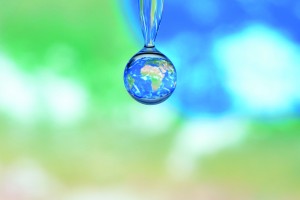 Two of the world´s biggest challenges are affordable renewable energy and abundant supply of clean water. Water scarcity is considered to be one of the issues of primary concern for the future.
Two of the world´s biggest challenges are affordable renewable energy and abundant supply of clean water. Water scarcity is considered to be one of the issues of primary concern for the future.
According to World Health Organisation “A lack of water to meet daily needs is a reality today for one in three people around the world. Globally, the problem is getting worse as cities and populations grow, and the needs for water increase in agriculture, industry and households.” [1]
The World Water Organisation also says only 20 per cent of the global population has access to running tap water.
For industrial processes such as in the textile industry, high volumes of fresh water are consumed[2]. The availability of water and energy, by consensus view of many experts, is the key issue in the future for many industrial processes. Water consumption has become a key topic in sustainability concepts of many large multinational corporations.
On the other hand, there is more than enough water on the planet, mostly in the form of seawater. Seawater contains by average 3.5% of salt, mostly sodium and chloride, and smaller amounts of calcium, magnesium and sulfates[3]. The salts have to be removed – the process is called desalination.
Various technologies are used for desalination of seawater to convert seawater into fresh water, usable for household, agriculture and industrial processes. Distillation, multistage flash distillation (MSF), and reverse osmosis (RO) are considered as state of the art technologies.
According to Huntington Beach Seawater Desalination Facility, “Desalination has evolved into a viable water supply alternative allowing to tap the largest water reservoir in the world – the ocean. Seawater desalination technology, available for decades, made great strides in many arid areas of the world such as the Middle East, the Mediterranean, and the Caribbean”[4].
Seawater desalination by today´s state of the art technologies is quite expensive, requiring a lot of capital cost for investment and a lot of energy to operate. Ultimately the supply of fresh water is connected with the cost of energy.
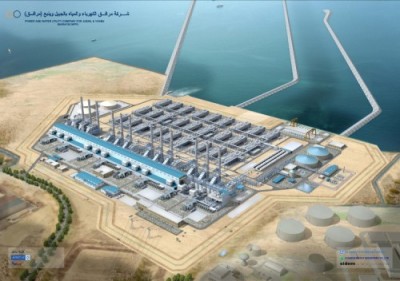
Today only 1% of the worldwide consumption of fresh water is desalinated water, of which 70% is in the Middle East where the energy to operate desalination plants is comparably cheap, the climate is arid and fresh water is costly[5]. Not surprisingly, the world´s largest desalination plant is located in Saudi Arabia[6]. In the United Arab Emirates (UAE) a high share of the water supply is based on seawater desalination[7]. Despite being a land of desert and sparse rainfall, the UAE is one of the highest water users in the world, with a daily consumption rate of 350 litres a person – 100 litres more than the global average[8].
Worldwide, according to Poseidon Resources Corporation, 21.000 desalination plants produce over 13 billion liters of potable water a day, and the installed capacity has grown exponentially over the last 30 years[4].
Reverse Osmosis (RO) desalination, using membranes typically made of polyimide or cellulose acetate, is still comparably expensive because of high pressure required to operate. The pressure is required to overcome the osmotic pressure of the ion solution in seawater.
Talking about technical details: the RO membrane typically exhibits a random size aperture distribution in which the maximum-size aperture is small enough to allow passage of water molecules and to disallow the passage of salt ions dissolved in water. The inherent random structure and thickness require comparably high pressures for operations.
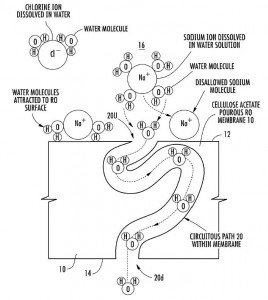
The productivity, energy use, salt separation efficiency, cost of production and durability of the membranes by and large determine the cost of the desalinated water. Technological improvements in all of these areas in the last two decades are rendering clean water supply from the ocean more affordable.
And the technology moves ahead even further: scientists at MIT have come up with a new approach using a different kind of filtration material for desalination – very thin sheets of graphene[9].
 Graphene is basically a monolayer sheet of graphite, a well known modification of elemental carbon[10]. The scientists claim the new material graphene would be far more efficient and possibly less expensive than existing desalination systems.
Graphene is basically a monolayer sheet of graphite, a well known modification of elemental carbon[10]. The scientists claim the new material graphene would be far more efficient and possibly less expensive than existing desalination systems.
The common membranes in existing reverse osmosis systems are about a thousand times thicker than graphene. Therefore new graphene system can operate at much lower pressure, and thus could purify water at far lower cost.
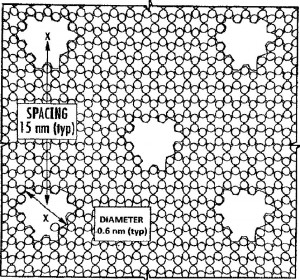
Lockheed Martin, the US aerospace and defense company, filed a patent application claiming a process using perforated graphene for deionization and desalination. The process would enable filter manufacturers to produce thin carbon membranes with regular holes about a nanometer in size that are large enough to allow water molecules to pass through but small enough to block the salt in seawater[11],[12].
The technology outlined in Lockheed´s patent is based on of nano-scaled graphene sheets perforated with plural aperture dimensions to block the specified ions as contained in seawater, mainly sodium and chlorine.
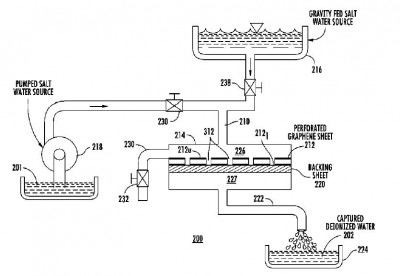
Lockheed and the MIT group are actually not the first scientists using nanoperforated graphene materials[13],[14].Graphene sheets containing perforations can be made by graphene oxidation through etching and chemical doping[15].
In a related approach, functionalized graphene nanopores in graphene monolayers have been developed by researchers at the University of Illinois at Chicago[16]. These materials could potentially be applicable as ionic sieves with high selectivity, simulating biological ionic channels. In this concept nanopores are terminated by negatively charged nitrogens and fluorines (N-F nanopores), favoring the passage of cations, and terminated by positively charged hydrogens (H-pores), favoring the passage of anions.
In another approach, Nanyang Technological Institute in Singapore has developed “a new wonder material”, a nanomaterial based on nano-sized titanium dioxide nanofibres which could be used for water filtration membrane systems for clean water production, besides other applications, ranging from solar cells, antibacterial bandages and longer lasting lithium batteries[17].
The latest progress in research and development of novel materials for membrane technologies, in particular nano-scale designed graphene membranes, is promising. This may allow more economical water desalination, and gives hope for a future of unlimited and affordable fresh water supply.
[13] Morse, Jeff; “Review of Kim, Myungwoong et al.;, Fabrication and Characterization of Large-Area, Semiconducting Nanoperforated Graphene Materials”; InterNano Resources for Nanomanufacturing; Apr. 30, 2010
[14] Kim, Myungwoong et al.;, “Fabrication and Characterization of Large-Area, Semiconducting Nanoperforated Graphene Materials”; Nano Letters 2010, vol. 10, No. 4, Mar. 1, 2010, pp. 1125-1131
[15] Liu, Li et al., “Graphene Oxidation: Thickness-Dependent Etching and Strong Chemical Doping”; Nano Letters 2008; vol. 8, No. 7, Jun. 9, 2008, pp. 1965-1970
[16] K Sint, B Wang, P Král – Journal of the American Chemical Society, 2008 “Selective ion passage through functionalized graphene nanopores“



Dear Mr. Schumacher,
We would like to present to you our new revolutionary process of seawater desalination in which we are imitating nature, which is producing for us huge amounts of pure rain water, by direct vaporization at room temperature. No boiling water, and no membranes. A very simple process which is similar to an industrial water cooler, in which a stream of air is cooling another stream of water by vaporizing some water, thus cooling the whole water stream. All we are adding, we are establishing a heat exchange between the resulting cold water and the output saturated air stream. Consequently water is condensed and collected.
Please visit our website at http://www.naturalseawaterdesalination.com for more information.